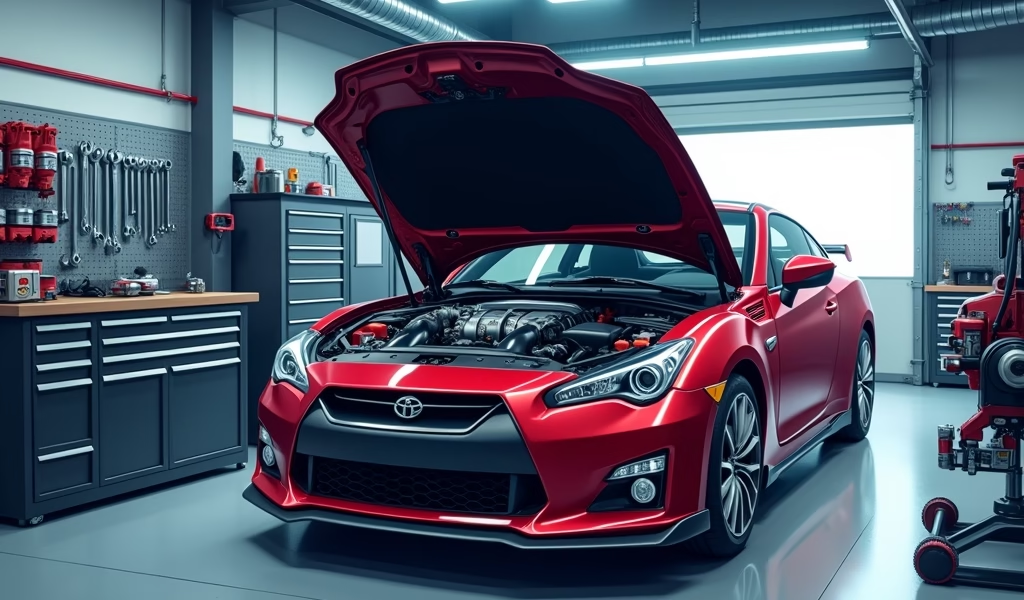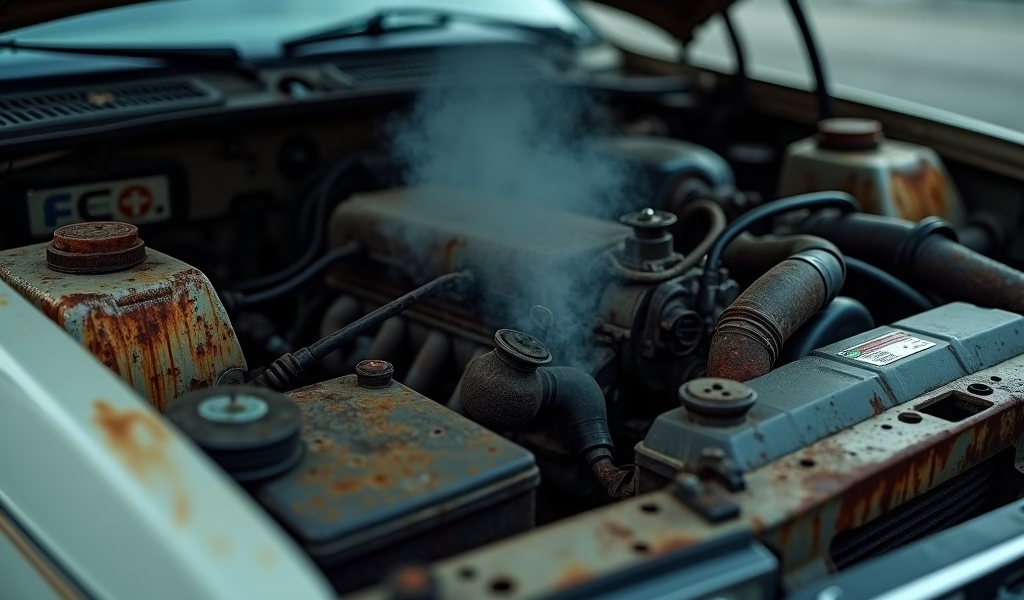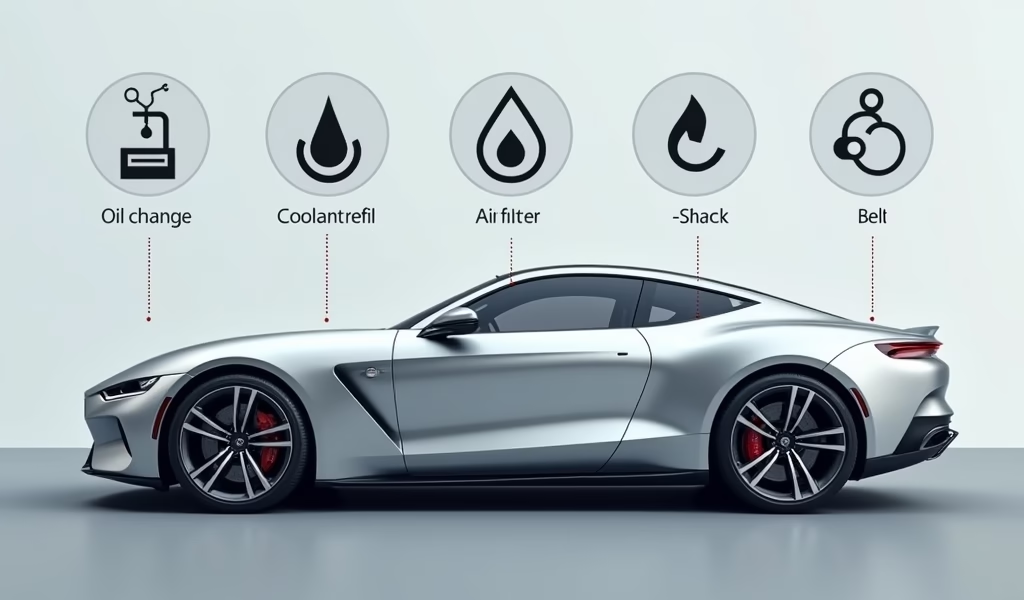Overview
This article explains how car engines work through the four-stroke cycle (intake, compression, power, exhaust) and identifies key components like pistons, crankshafts, and valves while offering practical maintenance tips such as regular oil changes and air filter replacements. It highlights common engine problems and their warning signs, discusses various engine types (inline, V-shaped, boxer, rotary), and emphasizes that proper maintenance is essential for extending engine life beyond 200,000 miles.
Table of Contents
- How Car Engines Work: The Basics
- The Four-Stroke Cycle: Power in Motion
- Key Components: The Engine’s Vital Parts
- Different Engine Types: What Sets Them Apart
- Common Engine Problems and Their Warning Signs
- Top 5 Care Tips: Keep Your Engine Running Smoothly
- Conclusion
- Frequently Asked Questions
How Car Engines Work: The Basics
When I pop the hood of a car, I’m looking at what I consider one of humanity’s greatest mechanical achievements – the internal combustion engine. How a car engine works isn’t magic, though it might seem that way when it transforms a few drops of fuel into enough power to move a 4,000-pound vehicle down the highway.
At its core, a car engine is a controlled explosion chamber. It takes fuel (usually gasoline or diesel), mixes it with air, ignites it, and channels the resulting explosive energy to turn your wheels. Pretty neat, right?
Think of your engine as a team of mechanical athletes, all working in perfect harmony. Pistons pump up and down, valves open and close with split-second timing, and your crankshaft converts all this furious back-and-forth movement into the rotational force that eventually reaches your tires.
Most modern cars use what we call a four-stroke engine. Don’t worry – I’ll break down what that means in terms that won’t make your head spin faster than a turbocharger.
The Four-Stroke Cycle: Power in Motion
The beating heart of most engines is the four-stroke cycle – a beautiful mechanical dance that happens thousands of times per minute. Let me walk you through it:
1. Intake Stroke
First, the piston moves down while the intake valve opens. This creates suction that draws in a mixture of air and fuel – just like you drawing in a breath.
2. Compression Stroke
Next, both valves close, and the piston moves back up, compressing the air-fuel mixture. This compression is crucial – it’s like packing gunpowder tightly before ignition.
3. Power Stroke
Here’s where the magic happens. The spark plug fires, igniting the compressed mixture. The resulting explosion forces the piston down with tremendous power – this is the only stroke that produces energy.
4. Exhaust Stroke
Finally, the exhaust valve opens, and the piston moves up again, pushing out the spent gases – like exhaling after taking a breath. Then the cycle begins again.
This entire four-stroke process happens incredibly fast. At highway speeds, each cylinder in your engine might complete this cycle more than 1,000 times per minute. It’s this rapid repetition across multiple cylinders that gives your car smooth, continuous power.
Modern engines are marvels of efficiency compared to their ancestors. Through advanced combustion research, engineers have squeezed more power from less fuel while reducing harmful emissions.

Key Components: The Engine’s Vital Parts
Now that you understand the basic process, let’s look at the key players making it all happen. Think of these components as the organs in your engine’s body:
Engine Block
This is the foundation – a heavy metal housing (usually cast iron or aluminum) that contains the cylinders and supports all other components. It’s built to withstand extreme pressures and temperatures.
Cylinders
These are the chambers where combustion happens. Most modern cars have four, six, or eight cylinders, though some have more or less. More cylinders generally mean more power but less efficiency.
Pistons
These movable plugs fit inside the cylinders and transfer the force from combustion to the crankshaft. They’re constantly moving up and down thousands of times per minute.
Connecting Rods
These connect the pistons to the crankshaft, transferring the up-and-down motion of the pistons into rotational motion.
Crankshaft
This spinning shaft converts the pistons’ reciprocating motion into rotational motion – much like how your legs power a bicycle crank. The crankshaft ultimately connects to your transmission and wheels.
Valves
These precision components control the intake of air/fuel and the exhaust of combustion gases. Timing their opening and closing is critical for engine performance.
Spark Plugs
These provide the spark that ignites the air-fuel mixture. Replacing spark plugs at regular intervals is essential for optimal engine performance.
Camshaft
This rotating shaft controls when and how long valves remain open. Modern engines often have multiple camshafts (DOHC, or Dual Overhead Cam systems).
Oil Pump and Lubrication System
This system ensures all moving parts receive constant lubrication to reduce friction and prevent wear. Regular oil changes are the single most important maintenance task for engine longevity.
Cooling System
Without proper cooling, an engine would destroy itself in minutes. The cooling system circulates coolant through passages in the engine block to absorb and dissipate heat.
All these parts work together with remarkable precision. Consider this: at highway speeds, your pistons might change direction 100 times per second, valves open and close 50 times per second, and the crankshaft spins about 3,000 times per minute – all while containing explosions hotter than 2,000°F!
Different Engine Types: What Sets Them Apart
Not all engines are created equal. Let’s explore the main types you’ll encounter:
Inline Engines
All cylinders are arranged in a straight line. These engines are simpler, more efficient, and cheaper to manufacture. You’ll commonly see inline-four engines in most everyday cars.
V-Shaped Engines
Cylinders are arranged in two banks at an angle (forming a “V”). This design allows for more cylinders in a smaller space. V6 and V8 engines offer more power and smoother operation, which is why they’re popular in larger vehicles and performance cars.
Flat/Boxer Engines
Cylinders lie horizontally opposed to each other. This creates a lower center of gravity, improving vehicle handling. Subaru and Porsche are famous for using boxer engines.
Rotary Engines
Instead of pistons, these use rotating triangular rotors. They’re compact and smooth but less common due to sealing challenges and higher emissions. Mazda’s RX series made these famous.
Diesel vs. Gasoline
Diesel engines use compression ignition (no spark plugs), while gasoline engines use spark ignition. Diesels typically offer better fuel economy and more torque but higher emissions of certain pollutants.
Hybrid and Electric Systems
While not traditional combustion engines, modern hybrid vehicles combine smaller gasoline engines with electric motors. Full electric vehicles eliminate the combustion engine entirely, using battery-powered electric motors instead.
Each engine type has its advantages and drawbacks. Vehicle manufacturers choose specific configurations based on their target market, vehicle size, desired performance characteristics, and regulatory requirements.
According to the EPA’s Automotive Trends Report, engine technology continues to evolve rapidly, with manufacturers achieving better fuel economy through turbocharging, direct injection, and hybrid systems.
Common Engine Problems and Their Warning Signs
After 20+ years fixing engines, I’ve seen it all. Here are the warning signs that should send you straight to the mechanic:
Check Engine Light
This dashboard warning is your engine’s way of saying “something’s not right.” Never ignore it. Modern engines have sophisticated sensors monitoring everything from oxygen levels to fuel mixture.
Unusual Noises
Engines should purr, not knock, ping, or rattle. Knocking often indicates improper fuel combustion. Ticking might suggest valve problems. Grinding could mean bearing failure – potentially catastrophic if ignored.
Loss of Power
If your once-peppy car now struggles up hills, you might have compression issues, fuel delivery problems, or clogged filters. Troubleshooting engine power loss early can prevent bigger headaches.
Excessive Smoke
The color tells a story. Blue smoke typically means burning oil (worn valve seals or piston rings). White smoke often indicates coolant entering combustion chambers (potential head gasket failure). Black smoke usually means too much fuel is being burned.
Overheating
Modern engines shouldn’t overheat with normal driving. If your temperature gauge climbs into the red zone, stop immediately. Continued driving can warp cylinder heads or crack the engine block.
Poor Fuel Economy
A sudden drop in MPG suggests something’s wrong. It could be as simple as a dirty air filter or as serious as failing oxygen sensors or fuel injectors.
The good news? Most engine problems give warning signs before becoming catastrophic. By staying alert to these signals and addressing them promptly, you can avoid being stranded and save thousands in repair costs.

Top 5 Care Tips: Keep Your Engine Running Smoothly
After decades working on engines, I’ve learned that maintenance is infinitely cheaper than repairs. Here are my top five tips to keep your engine purring for years to come:
1. Change Your Oil Religiously
Nothing – and I mean nothing – is more important for engine longevity than fresh, clean oil. It lubricates moving parts, reduces friction, transfers heat, and carries away contaminants.
For conventional oil, change every 3,000-5,000 miles. For synthetic, 7,500-10,000 miles is typical, but always follow your manufacturer’s recommendations. And don’t forget the filter!
Pro tip: Keep a log of oil changes in your glove compartment. Your future self (and the next owner) will thank you.
2. Replace Air Filters Regularly
Your engine breathes through its air filter. A clogged filter forces your engine to work harder, decreasing power and fuel economy.
Check it every 15,000 miles, but dusty environments may require more frequent changes. It’s an inexpensive part that makes a big difference.
Bonus: Replacing a dirty air filter can improve fuel economy by up to 10% – that’s like getting a free gallon of gas with every tank!
3. Mind Your Cooling System
Overheating can destroy an engine in minutes. Check coolant levels regularly and flush the system according to your manufacturer’s schedule (typically every 30,000-60,000 miles).
Watch for leaks – those small damp spots under your car can be early warning signs. And never open a hot radiator cap – the pressurized fluid can cause severe burns.
4. Use Quality Fuel and Keep the Tank Above Quarter-Full
Your engine deserves better than the cheapest gas available. Higher-octane fuels aren’t necessary unless specified for your vehicle, but choosing quality fuel from reputable stations makes a difference.
Running consistently near empty forces your fuel pump to work harder and can cause it to overheat. The sediment that naturally settles at the bottom of your tank can also be drawn into the system when levels are low.
5. Listen to Your Engine
Develop a relationship with your car. Learn its normal sounds, vibrations, and performance characteristics.
When something changes – a new noise, vibration, or performance issue – don’t ignore it. Small problems rarely fix themselves and often grow into expensive repairs.
Follow these five simple practices, and you’ll likely squeeze tens of thousands of extra miles from your engine. The modest time and money invested in maintenance will pay enormous dividends in reliability and reduced repair costs.
Conclusion
Your car’s engine is a marvel of engineering that converts simple chemical energy into the power that moves your life forward. By understanding how a car engine works – from the four-stroke cycle to the symphony of components working together – you gain appreciation for this mechanical wonder and the knowledge to keep it running smoothly.
Remember that regular maintenance isn’t just about preventing breakdowns; it’s about preserving performance, efficiency, and the significant investment your vehicle represents. The most expensive engine repairs often result from neglecting simple, inexpensive maintenance.
Listen to your engine, treat it with respect, and it will reward you with years of reliable service. After all, in the relationship between car and driver, a little mechanical empathy goes a long way.
Frequently Asked Questions
How long should a properly maintained engine last?
Most modern engines can last 200,000-300,000 miles with proper maintenance. Regular oil changes and addressing minor issues promptly are key to achieving maximum longevity.
Why does my engine make a knocking sound?
Engine knocking usually indicates improper fuel combustion, often from low-quality fuel or carbon deposits. It can also signal worn bearings or other internal components requiring immediate attention.
Do I really need synthetic oil in my engine?
While conventional oil is adequate for many vehicles, synthetic oil offers better protection, especially in extreme temperatures and high-performance applications. Check your owner’s manual for the manufacturer’s recommendation.
What happens if I skip oil changes?
Skipping oil changes leads to sludge buildup, increased friction, and accelerated wear on engine components. Eventually, this can cause catastrophic engine failure requiring complete replacement.
Is premium fuel better for my engine?
Premium fuel is only necessary for engines specifically designed for it. Using higher octane fuel in an engine designed for regular gas provides no benefit and wastes money.

